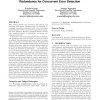7 search results - page 1 / 2 » Self-checking instructions: reducing instruction redundancy ... |
IEEEPACT
2006
IEEE
13 years 10 months ago
2006
IEEE
With reducing feature size, increasing chip capacity, and increasing clock speed, microprocessors are becoming increasingly susceptible to transient (soft) errors. Redundant multi...
HPCA
2006
IEEE
14 years 4 months ago
2006
IEEE
With reducing feature size, increasing chip capacity, and increasing clock speed, microprocessors are becoming increasingly susceptible to transient (soft) errors. Redundant multi...
HPCA
2008
IEEE
13 years 10 months ago
2008
IEEE
With reducing feature size, increasing chip capacity, and increasing clock speed, microprocessors are becoming increasingly susceptible to transient (soft) errors. Redundant multi...
DFT
2006
IEEE
13 years 10 months ago
2006
IEEE
Control flow checking (CFC) is a well known concurrent checking technique for ensuring that a program’s instruction execution sequence follows permissible paths. Almost all CFC...
HPCA
2008
IEEE
14 years 4 months ago
2008
IEEE
The continued scaling of device dimensions and the operating voltage reduces the critical charge and thus natural noise tolerance level of transistors. As a result, circuits can p...

